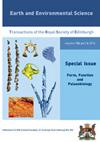始新世波罗的海琥珀中神秘的棘甲虫属棘甲虫的第二个化石种,对雌性生殖器形态的启示(鞘翅目:棘甲虫科:棘甲虫科)
IF 1.2
4区 地球科学
Q4 GEOSCIENCES, MULTIDISCIPLINARY
Earth and Environmental Science Transactions of the Royal Society of Edinburgh
Pub Date : 2021-12-06
DOI:10.1017/S1755691021000360
引用次数: 3
摘要
粉虫亚科是一种小型且可能非单系的粉虫亚科。神秘的Charhyphus Sharp, 1887一直被置于Phloeocharinae中,然而最近的研究发现它在系统发育上与该亚科的核心成员非常遥远,这表明它实际上有可能值得单独的亚科地位。到目前为止,Charhyphus唯一确定的化石记录是基于始新世波罗的海琥珀中的单一雄性,由†Charhyphus balticus Shavrin, 2020代表。在这里,我们描述和说明了另一个新的char菌类,†char菌类serratus sp. nov. Yamamoto & Shavrin,来自波罗的海琥珀,基于一个保存完好的女性化石。考虑到身体和头部的总体比例,这个新物种与†C最相似。balticus。该新种与所有已知种的不同之处在于,其前角外侧边缘发育有强烈的锯齿状,中腔岩顶端边缘的形状具有特征。通过x射线显微计算机断层扫描,我们不仅成功地可视化了一般习性,而且成功地可视化了每个个体的身体部位,并在该属的雌性内生殖器上恢复了以前未记载的硬骨。本文简要讨论了已灭绝种和现存种的形态特征。还提供了所有现存的炭疽菌种类的图和该属的钥匙。我们的研究对考虑可能的更高的古多样性、更常见的分布和古生物地理具有重要意义。本文章由计算机程序翻译,如有差异,请以英文原文为准。
A second fossil species of the enigmatic rove beetle genus Charhyphus in Eocene Baltic amber, with implications on the morphology of the female genitalia (Coleoptera: Staphylinidae: Phloeocharinae)
ABSTRACT Phloeocharinae is a small and likely non-monophyletic subfamily of rove beetles. The enigmatic genus Charhyphus Sharp, 1887 has long been placed in Phloeocharinae, whereas recent studies have found it to be phylogenetically very distant from the core members of this subfamily, suggesting the possibility that it actually deserves its own separate subfamily status. So far, the sole definitive fossil record for Charhyphus is known based on a single male from Eocene Baltic amber as represented by †Charhyphus balticus Shavrin, 2020. Here, we describe and illustrate another new Charhyphus species, †Charhyphus serratus sp. nov. Yamamoto & Shavrin, from Baltic amber based on a well-preserved female fossil. Considering the general proportions of the body and the head, this new species is most similar to †C. balticus. The new species differs from all known species by the development of strong serration of the lateral edges of the pronotum and features of the shape of the apical margin of the mesoventrite. By using X-ray micro-computed tomography, we succeeded in visualising not only the general habitus but also each individual body part, recovering a previously undocumented sclerite on the female internal genital segments in the genus. Morphological features of extinct and extant species of Charhyphus are briefly discussed. Figures of all extant Charhyphus species and a key for the genus are also provided. Our study is important for considering possible higher palaeodiversity, more common occurrence, and palaeobiogeography of Charhyphus.
求助全文
通过发布文献求助,成功后即可免费获取论文全文。
去求助
来源期刊
CiteScore
2.00
自引率
0.00%
发文量
21
期刊介绍:
Earth and Environmental Science Transactions (formerly Transactions of the Royal Society of Edinburgh: Earth Sciences) is a general earth sciences journal publishing a comprehensive selection of substantial peer-reviewed research papers, reviews and short communications of international standard across the broad spectrum of the Earth and its surface environments. The journal prides itself on the quality of its graphics and photographic reproduction. The Editors are keen to encourage interdisciplinary papers and Transactions also publishes occasional special symposia and invited volumes of specific interest.
We are currently in the process of digitising the archive of RSE Publications, and the archive of the Transactions, dating back to 1788, will be available from the back issues link on this site.

 求助内容:
求助内容: 应助结果提醒方式:
应助结果提醒方式:


